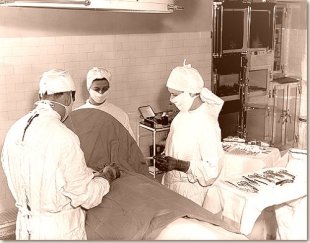Treatments of Tuberculosis |
|||||||||||||||||||||

|
|
|
|||||||||||||||||||
|
Situated at the bottom of the chest and separating the chest from the abdomen are two muscles, one on each side and together known as the diaphragm. The muscle on the right side receives its nerve supply from the right phrenic nerve and that on the left, naturally, from the left phrenic nerve. As you breath in, both muscles contact and are pulled downward thus increasing the volume of the chest and drawing air into the lungs. At the end of a deep breath the muscles relax and rise pushing the air out of the lung. In other words breathing in is an active or contracting phase of the diaphragm and breathing out is a passive or relaxing phase of the diaphragm. In 1902, two American physicians showed that this phrenic nerve could be paralysed without the patient necessarily dying as a result. If the nerve supply to one diaphragm is cut off, that diaphragm is paralyzed and remains in a relaxed phase, that is, higher in the chest. In this way not only are the respiratory movements of the lung diminished but also, due to the rising of the diaphragm slightly in the chest, there is a small decrease in volume of the lung. The diaphragm opposite to the phrenic nerve crush continues to act normally. Both phrenic nerves, that is, right and left, rise from a group of nerves in the neck, some of which go on to supply the shoulder muscles and arm muscles and the phrenic nerve enters the chest behind the collar bone. However, between the place where it originates and where it disappears into the chest it is readily accessible through a small incision made in the skin just above the collarbone. You can compare the crushing of this nerve to the cutting of a wire carrying electrical current to a lamp. By cutting the wire the light is extinguished and similarly by crushing the phrenic nerve the current which causes the contraction of the diaphragm is temporarily cut off. Following a phrenic nerve crush the diaphragm remains paralyzed for varying periods, usually anywhere from three to six months and then the diaphragmatic movement gradually returns. If we wish to have a permanent paralysis of the diaphragm we actually remove a small portion of the nerve, rather than simply crushing it, and then the diaphragm permanently loses its nerve supply. Usually several phrenic nerve "recrushes" can be performed before too much scar tissue forms to make the operation too difficult. Modified from "Phrenic Nerve Crush" by Dr. WA Allen, a physician at the Saskatoon Sanatorium, in the 1949 Valley Echo [volume 30(4), pages 7-8]. This type of surgery to reduce the volume of the lungs was proposed for use in treatment of Tuberculosis in 1911, but was not commonly used until after 1934. | |||||||||||||||||||||

